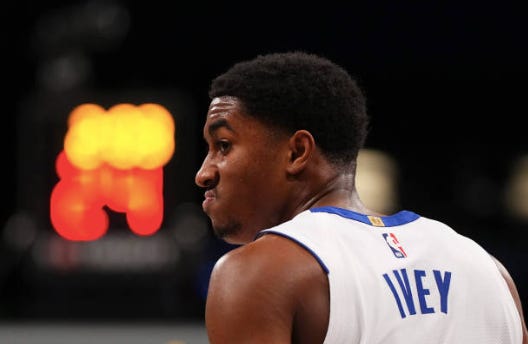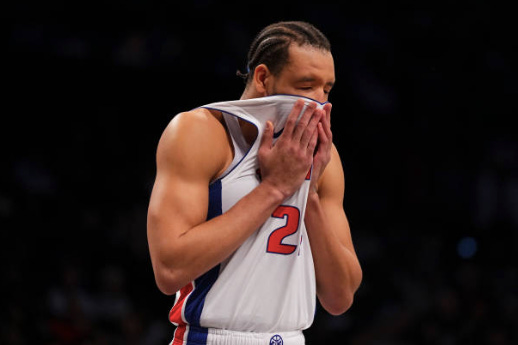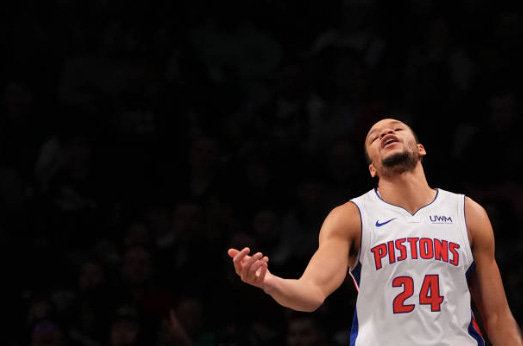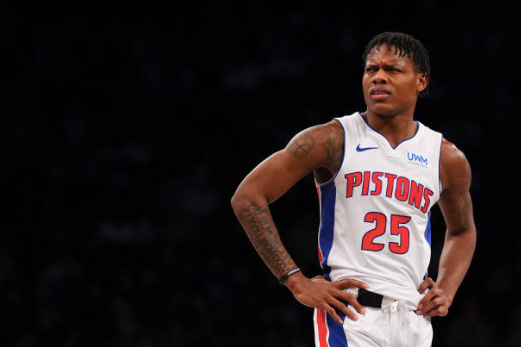Due for some desperation
Detroit, the purpose of the Pistons, and intention.
When people, now and for the last few years, talk about the intention of the Detroit Pistons, what they mostly mean is the purpose. The point. Swap the words in any recent analysis and you’ll see they’re interchangeable.
Separate seeming, but very central to this it seems to me, is how people think about Detroit — the city, the place, its people, the promise, and reality (perceived and actual). How people think of it preempted by the prospect of whether they even do and as with the Pistons, probably won’t unless the situation is dire.
Inhabited by indigenous people as far back as 11,000 years ago, at one time the third largest city in the province of Quebec, behind Quebec City and Montreal, stubborn holdout in the American Revolutionary War and War of 1812, less a cradle than a spark plug of culture, arts and municipality made monolith, driven to preeminence on the wheels of the car and then stalled out, marred up by highways as redlines, further depressed and disconnected as the auto industry crashed, Detroit has always seemed a city worth understanding. As a microcosm, it was an example to other cities the danger and damage of conforming too narrowly and completely to one enterprise, controlled by a powerful few, accelerated by sociological pressures which are themselves, up through time, always repeating. A lesson in restraint as much as an example of joy, or promise in work, like the strength of some of those first auto workers unions, or in Motown — Kim Weston’s sublime choral climb, the sweet wrenching of Smokey Robinson.
Detroit was formative to basketball, and to basketball for me. There’s St. Cecilia’s in West Detroit, started by Sam Washington, a gym teacher, and called The Sanctuary to some because of its role as drop-in haven during the tensions that led to the 1967 riots in the city. In 1974, a contract dispute between Hall of Famer Dave Bing and the Pistons that kept Bing from practicing with the team led him to working out at St. Cecilia’s with his friend, Washington. Washington, knowing the team donated most fines to charity, had the Pistons divert everything the team was collecting from Bing to St. Cecilia’s. The little church court got a new hardwood floor, and basketball snowballed there into pick-up games that went all day, a pro-am summer tournament dubbed The Saint, and a revolving door for alumni and pros in town who wanted to play.
Before the riots, the Pershing High School basketball team, the Doughboys, won the Class A State title — the first time in 37 years a team from the Detroit Public School League won a state championship. The team was coached by Will Robinson (the Pistons team that won the title in 2003-2004 — probably my favourite Pistons team — renamed their locker room that season ‘Will Robinson Locker Room of Champions’) and included Spencer Haywood and Ralph Simpson. Robinson, who’d left Virginia due to segregation in pursuit of his Master’s degree, was a rare-for-the-time Black head coach, coaching a rare-for-a-city smouldering with racial tension predominantly Black team. At the time, prior to the post-riot white-flight and save for the historic Black Bottom neighbourhood, most of Detroit’s inner-city population was white. Robinson went on to make a name for the program but his main concern was fostering a sense of confidence, of excellence and promise, in the kids he coached.
In broader, strictly NBA terms, the Bad Boys era Pistons ushered in a new style of gameplay. Bullies who weren’t afraid of being called bullies, bruisers who could throw their weight around one step and in the next, collect in transition to go skimming light as a feather down the floor. It was skilled, unapologetic basketball. It was also the first time the sport snagged me, brash and a bit scary, but in the welcome way kids want. Dennis Rodman certainly came into himself, the caricature of himself, with the Bulls and alongside Michael Jordan, but the raw energy of him then, and that team (including future formative Raptor John Salley) stuck for me.
I have since followed the Pistons rise and fall, in lilts, rampaging peaks and big, big nosedives, with the same attention you give idly to a home team. Though, maybe with a bit more leeway for faults and franchise failures (the Stan Van Gundy double-duty era) because at the end of the day I’ll never be able to feel the hurts of the team, its city, as deep.
On a trip to Detroit to visit friends for the Fourth of July we’re asked at the border what the purpose (e.g. point) of our visit is. When he finds out where we’re staying, the border guard makes his eyes go cartoon wide and says he wouldn’t go there “without heat”, patting the literal gun at his bulging waistline like it wasn’t — like he didn’t ensure it would be — eye-level for us looking up from the car into the booth. He reveals to us he does not live in Detroit.
Later, we watch the evening come down heathery mauve from out on the old porch, holding necks of High Life bottles beading against the softening heat. Fireflies bob and flicker in a copse of overgrowth at the end of the street, going in and out of a car up on blocks with its windows down. We walk slow through the neighbourhood, happy to stretch our legs as day-early fireworks in the hands of eager families go off and kids hoot and howl with the scattering blooms, last of their sparks filtering down through the massive black oaks.
Troy Weaver built this team over four years. Another way people might interpret that: Troy Weaver had four years to build this team?
There’s fault here, to be sure, but watching the Pistons this season inch closer to a historic losing record, a record no one wants and will likely take a long time in the NBA’s current competitive climate for another team to break, I still hold true to the thing I’ve been saying for this and the three seasons before: the team is too good to be this bad.
Middling good, flash-in-the-pan good, inconsistent and rangy and untidy good, but still: good.
There is hope, but does it have legs?
They’ve lost more games in clutch time this season that any other team, shooting 20% from the field, 15.8% from three in those minutes. The optimistic upside of that is they’ve been that close for that many games to winning. They’ve also spent more days above .500 than a handful of teams have, and the same amount of time there as the Toronto Raptors, even with their seemingly spectrums-opposite records.
There is hope, but does it have intention?
The saying, “The road to hell is paved with good intentions” is of unknown origin and has been attributed to Virgil, the Book of Sirach, the Hadith, a co-founder of Knights Templar and has been used by everyone from Charlotte Bronte to Karl Marx to Ozzy Osbourne.
The universality of the proverb underscoring its main irony, that it’s other people’s intentions we first qualify as mistakes.
Tom Gores bought the Pistons in 2011. In that time he’s hired four heads of basketball operations and six head coaches.
Gores, whose company Platinum Equity makes a profit by buying flailing businesses and gutting them before selling them off, bought the United States’ largest prison telecom company, Securus, in 2017. Securus charges the families of incarcerated people an exorbitant amount to make phone calls to them in prison, up to a dollar a minute. One in three families goes into debt to stay connected, a burden shouldered by predominantly women, and predominantly women of colour. Since Gores acquired Securus, the company makes close to $700 million per year, and grew its profits by 10% during the pandemic when in-person visits were shut down and telecommunication was the sole option for staying connected.
Gores, who grew up close to Flint and lives in Beverly Hills, has donated nearly $10 million to the ongoing Flint water crisis, paid for the Pistons move into the city from Auburn Hills, contributed to community initiatives around Detroit, and seemed surprised at the attention his company buying a predatory tool for the already predatory American Prison-industrial complex brought him.
“I didn’t realize that there would be this much headline risk,” he said in 2019. In October 2020, Gores resigned from the LACMA Board of Trustees following pressure and local protest from artists about his involvement with Securus.
When Gores has spoken about it, namely whether he’s going to sell Securus when rightly confronted about it, he’s framed his ownership stake as a kind of stewardship.
“We are not going to pop in, make a few bucks and pop out. We are going to make it right first,” Gores has said.
Gores was briefly engaged in talks with advocacy groups for prison reforms, and had scheduled meetings with impacted families he cancelled. He hasn’t clarified what making it right is, and whether it means lowering costs for calls or reforming the pay to use system all together and making it free, as his home state of California did last December. He has popped in and made quite a few bucks, though.
Studies have shown that babies develop the understanding of intention, that is to infer the intention of an action even if it’s not successful, between nine and 15 months of age.
Deciphering intention via observation doesn’t leave us in the cradle. In studies through the 1980s and 90s, a group of researchers were able to identify the presence of mirror neurons while examining the brains of macaques. They found that some of the same neurons fired when the monkey reached for and lifted up pieces of food itself as when it watched a person reach for and lift food in front of it. With further research, it was found that about 10% of neurons in inferior frontal and inferior parietal cortices of monkeys have mirror properties.
Functional neuroimaging and the introduction of functional magnetic resonance imaging (a real-time look at the functioning of the entire brain) has shown a much wider network for neurons with mirroring properties within the human brain than just our frontal lobe. For example, our somatosensory cortex — a slice smack dab across the middle concerned with detecting touch, the position of our bodies in space, the perception of pain and temperature — lights up when we observe someone or something else experiencing these sensations. In other words, bodily empathy.
There have been studies attempting to bridge the presence of mirror neurons to the act, or sensation, of empathy in humans, but because these studies are relatively new and studying the human brain, in general, is complicated, the jury’s still out. It’s a minuscule sample size, and an imperfect control group, but 99% of the time: if I see someone crying, I’m going to choke up.
At the party, Yusef’s three-year-old daughter running around on her short, sturdy legs, grabbing deliberate handfuls of the food eye-level with her on the jammed full and festive dining table, pushed from the middle of the room against the wall. Here one shrimp, there one slice of crusty baguette, a hunk of cheese, then weaving through all the legs around her to make it back to the lounger by the fireplace. On another trip, she manages to haul the hidden refrigerator open and gets her uncle Davey (who as long as this party has been happening I’ve considered little, but now he’s past the age we were when we started coming) to bring down a clamshell of raspberries from the shelf so she can clench two fistfuls and put them on a plate, take them back to the chair.
She tails a dachshund named Jerry under tables and around chairs. She lays down on a rug to take a rest and the crowd, everyone in their own pockets and clumps of conversation, instinctively shifts around her. She takes large chunks of ice from a metal bucket on the floor and places them one at a time in a tea towel to bring to people for their drinks, whether they need ice or not. Escaped from having her pajamas put on, she runs up the stairs and over the living room’s long built-in bench seating, squeezing behind Dylan to come laughing to my lap where she sits facing me and we pull faces while her five-month-old sister sleeps sprawled across Yusef beside us.
Her intentions, only actions. The direct line between her and what or who she perceives and wants. And the world, turned immediate and small as a warm house by the water filled with her family and friends, acquiesces. A fleeting state to envy, and protect.
People say the league is better when the Knicks are good. I feel that way about the Pistons.
Gores recently gave a long interview to media about the state of the team, the gist of which was honestly not much. He talked a lot about reflection, urgency, the team being nimble now that it wasn’t so bogged down in contracts — the state of nimble-ness almost as a longed for Valhalla:
We’ve built ourselves to be flexible and nimble, so we’re not stuck in this problem. We have a problem. We’ve lost way too many games. We’re not stuck in it, though. We’re nimble. We can bounce from this. We have a tremendous amount of cap space.
It goes on in the same cyclical way, a merry-go-round of executive-speak that, for anyone who has been in a room with or worked for these kinds of people, understands well the grift of saying a lot without saying anything.
Like rhyme-schemes, little cul-de-sacs of speech meant to pick us up and put us down in exactly the same place, they continue:
We’re not right, right now. We have to add and delete. We’re on it already. We will make changes. We will make them. We don’t know exactly what they’ll be yet.
I think part of going forward in life is being honest with yourself. We’re being honest with ourselves.
We have to figure out how to right the ship. The ship is not sinking, but we have to right the ship.
We have to be honest enough with ourselves and not be stuck in a strategy. The worst leaders don’t know how to adjust. We have to navigate and adjust.
It all reads as desperate as I’m sure he understand he needs to sound, but the desperation never rests on men, on owners, like Gores. The desperation lies with the team itself, with Monty Williams who seems checked in on a personal level with the players he coaches but not competitively, with Weaver, and with fans who do not want to achieve the kind of record the team is about to.




The Pistons are due for some desperation. For some intentional, clawing, trying with full force to get and keep their legs under them desperation, and they aren’t going to find it from Gores.
Pure intention, funnelled into action, the brain firing urgent. Detroit has seen all these things before. It lives deep in the muscle of the place as memory even if, for the team, those habits have been entombed, calcified in carelessness and now, further dulled by endless doublespeak.
On another trip to Detroit: The best guacamole of my life at a red checkered cloth place in Mexicantown — rich, slightly cold, frothy, almost whipped. Getting a tiger head tattooed on my bicep. Finding a big pool party on the roof of a building downtown, at least 30 stories up, and right next to it’s a beautiful 1920s tower, abandoned, the afternoon sun softening stern faces of art deco reliefs carved into the stone between blown-out windows so the figures seem to squint over at us in the water, even wink.
Driving out to the Palace of Auburn Hills for a game and leaving with a Bad Boys snap-up jacket, driving back into the city with it on, watching the towers of downtown get nearer, some blacked out in abandonment but some, beginning to glow.


This is so wonderful, thank you.
I lived in Detroit for a few years out of college. It will always hold a special place in my heart - even the Pistons, though I am and was raised a Bulls fan. Thanks for this piece.